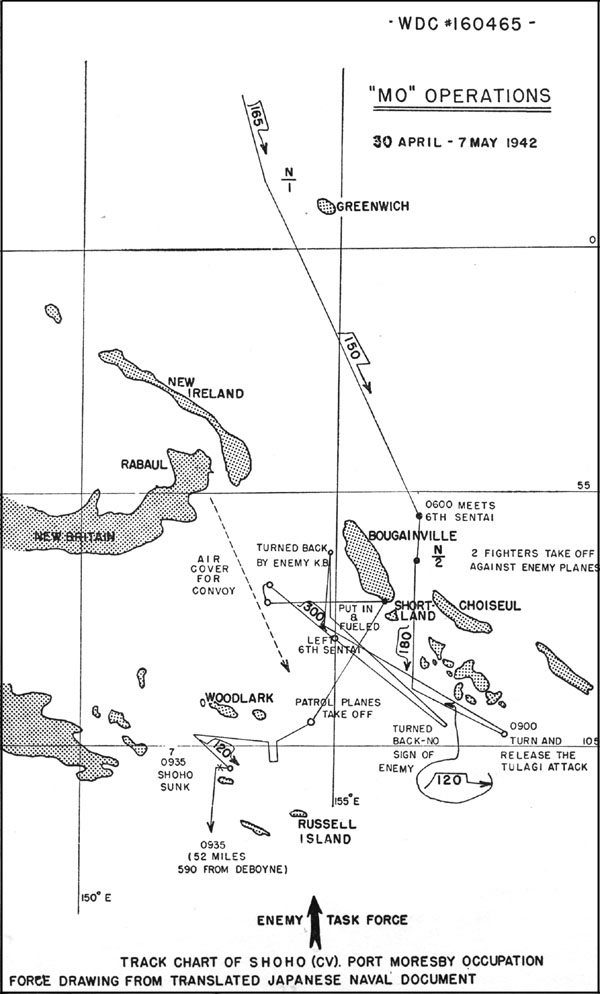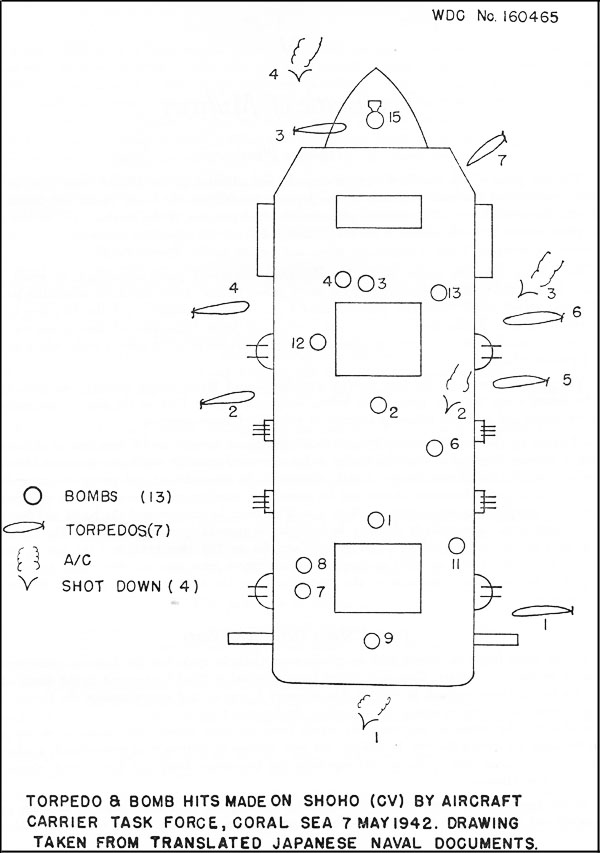

| Additional material is available for the Battle of the Coral Sea. |
The first of these expeditions planned was the capture of Port Moresby, in southeastern New Guinea, which was to form a southern outpost of the Japanese defensive system. Seizure of this location would deny to the Allies a potential base within air range of Rabaul, and would establish the Japanese in a position dominating the Northern Australia and New Guinea areas. On 30 April 1942 an occupation force with strong combatant escort departed Truk and sailed southward. Occupying Tulagi on 3 May, this force then proceeded through the Solomon Sea toward Port Moresby.
To counter this anticipated move, a United States task force built around the carriers Lexington and Yorktown entered the Coral Sea to meet the advancing Japanese, and "to destroy enemy ships, shipping, and aircraft at favorable opportunities in order to assist in checking the advances by the enemy in the New Guinea-Solomons area."
While United States aircraft were searching for the Moresby invasion fleet, long-range Japanese land and sea planes based at Rabaul and in the Shortland Islands searched unsuccessfully for the United States task force, the main portion of which was operating to the southeast of the Louisiade Islands while a small supporting cruiser group proceeded independently to an area south of New Guinea in the hope of intercepting the Japanese transports.
At about 0845 on the morning of 7 May United States carrier search planes located a portion of the Japanese transport force including the aircraft carrier Shoho near Misma Island. This group was immediately attacked by aircraft from both Yorktown and Lexington. Dive bomb and torpedo hits sank the Shoho within 15 minutes of the first hit. At the same time as the attack on Shoho, a striking group from the Japanese carriers which were operating in support to the eastward and were as yet unlocated by the United
States forces, located and sank the United States destroyer Sims and critically damaged the fleet oiler Neosho.
Throughout the remainder of the 7th land-based aircraft both United States and Japanese searched for but failed definitely to locate the opposing carrier task forces. Early the next morning, however, the two forces located each other and simultaneously launched aircraft to attack. In the resulting exchange of blows the Japanese carrier Shokaku received severe damage as a result of six hits by dive bombers, while the United States suffered damage to both Yorktown and Lexington, and the latter, with uncontrollable gasoline fires and delayed fuel tank explosions had to be abandoned and sunk by United States destroyers.
Report of Kinyoka Maru, WDC No. 160252.
Supplemental Report of USSBS Field team No. 3 on Truk and Coral Sea.
Damaged
DamagedConsequences of the Engagement
As a result of the loss of the Shoho, damage to the Shokaku, and heavy loss of pilots and aircraft from both their land-based and their carrier air groups, Japanese support force was greatly reduced. For this reason the invasion force retired and the date of projected occupation was postponed to July. In June however, the disastrous losses in carrier strength suffered by the Japanese at Midway forced final abandonment of the plan to invade Port Moresby by sea. With the turning back of the Port Moresby occupation force at the Battle of the Coral Sea, the Japanese southward expansion by sea was stopped and a base saved to the Allies which was destined to be the principle stepping stone in the Allied advance through New Guinea.
Bibliography
Records of 6th Cruiser Division, WDC No. 160997.
Carrier Operations, WDC No. 160677.
War Diary of 25th Air Flotilla, WDC No. 161725.
Nav No.
U.S.S.B.S. No.
Vice Admiral Jisaburo Ozawa, IJN (Philippine Sea)
3
32
Commander Sekino (Solomons and Santa Cruz)
16
75
Captain Yamaoka (Coral Sea)
10
53
Rear Admiral Komura (Chikuma and Tone)
106
464 Forces Involved
UITED STATES
JAPANESE
Minneapolis (CA)
Rear Admiral F.J. Fletcher
New Orleans (CA)
Astoria
Rear Admiral W.W. Smith
Chester
Portland
Yorktown
Rear Admiral A.W. Fitch
Lexington
Phelps
Capt. A.R. Early
Dewey
Farragut
Aylwin
Monaghan
Morris
Capt. G.C. Hoover
Anderson
Hamman
RussellKashima (OCL)
Vice Admiral Inoue (At Rabaul)
CarDiv 5
Rear Admiral Hara
Zuikaku (CV)
Shokaku
CruDiv 5
Vice Admiral Takagi
Myoko (CA)
Haguro
Ashigara
DesDiv 27 (4 DD)
DesDiv 8 (2 DD)
Tokiwa (CM)
Koyokawa Maru
Toho Maru (AO)
Support Group
Australia (CA)
Rear Admiral J.G. Grace RN
Chicago
Hobart
Perkins
Walke
Occupation Force
CruDiv 6
Aoba (CA) (F)
Kinugasa
Kako
Furutaka
CruDiv 18
Tenryu (F) (CL)
Tatsuta
Shoho (CVL)
1 DD
DesRon 6
Yubari
6 DD
Kanikawa Maru (XAV)
Tsugaru (CM)
5 APs
SubRon 8
6 SS Detailed Losses
Ships
UNITED STATES
JAPANESE
Sunk
Lexington (CV)
Neosho (AO)
Sim (DD)
Yorktown (CV)Sunk
Shoho (CVL)
Kokuzuki (ODD)
Landing Barges (4)
Shokaku (CV)
Okinoshima (OCL)
Yuzuki (ODD) Captain and other killed by strafing.
Aircraft
66
80
Personnel
543
900 (about) Track Chart of Shoho

Torpedo & Bomb Hits Made on Shoho
